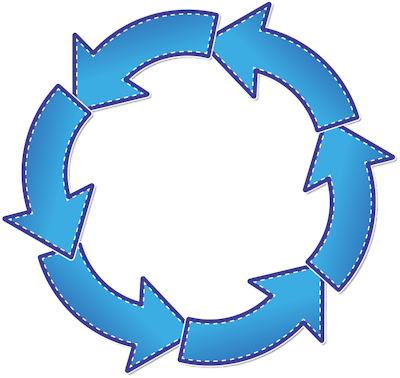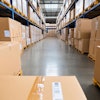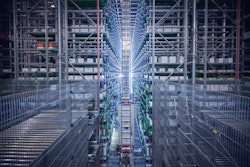
Most think of the supply chain as a forward-moving process with one end goal—getting product into the customer’s hands. But the growth of e-commerce and greater consumer awareness has created new challenges not only in moving a product forward but also backward. The days of a linear supply chain have long passed, making way for a circular economy, where your supply chain’s reverse logistics are just as important as its forward motion.
According to the Reverse Logistics Association (RLA), the term “reverse logistics” refers to all activity associated with a product or service after the point of sale, with the ultimate goal to optimize (or make more efficient) aftermarket activity, thus saving money and environmental resources.
“If you build and design products for cradle to grave operation, they’re build in a factory, shipped, sold and eventually, when they stop being useful, end up in a trash heap,” explains Tony Sciarrotta, executive director, RLA. “You can look at that process in many ways. While it's not environmentally sound, it's also a bad business decision. If you can recover assets from the product at the end of its life, by reusing, rebuilding or refurbishing it— anything that you can do to bring that product back to life—is not only avoiding landfills but also protecting assets and resources. We used to call it sustainability, but it’s become more than that.”
In today’s supply chain, when a product reaches end of life, the question has become: What else can you do with it? What can you do with this product instead of disposing it?
Sciarrotta says there a number of answers to that question.
“There is no one silver bullet in this gun. There's a lot of them, again, depending on the product category,” he says.
Walmart, he explains, is a great example of a circular supply chain. The retailer partners with certain third-party solutions providers, who say, "I'll go to your warehouse, I'll touch this stuff, I'll sell it right from your warehouse, and we'll sell it right to an end consumer."
Some manufacturers, such as Nike or Peppermill, however, prefer to take product back, and then sell it themselves to secondary outlet stores like Big Lots or Bargain Outlets.
Sciarrotta adds that currently there is a lot of creativity in the reverse logistics space “in the sense of using Craigslist, using eBay, using Amazon Warehouse for open box goods.”
Linda Li, chief strategy officer at Re-Teck, which provides reverse supply chain management (RSCM) solutions for OEM and enterprise businesses in the technology, electronics and telecom (TET) sectors, notes that there is another side of reverse logistics, or reverse supply chain, beyond the more commonly understood retail space.
The second categorization, post-industrial recovery, pertains to supply chain assets that could be spare parts, situated anywhere along the supply chain network, such as a retail center, a distribution center, or even in the factory, but not yet in the consumer’s hands.
“The post-industrial side is actually quite substantial as you can imagine,” Li explains. Part of what Re-Teck does is make sure that these assets are being handled properly, whether they can be repurposed or recycled in an environmental and socially responsible way.”
Financial Motivation
Whether your reverse supply chain is in the post-retail or post-industrial market, what to do with a return ultimately comes down to the bottom line.
“You have to make these decisions of what to do with the item, based on the financial aspect,” emphasizes Sciarrotta. For example, as a manufacturer, if it's a $50 pair of shoes being returned, is it worth it to pay for the shipping all the way back to you?
“That's a financial decision, and the best companies are using good financial analyses to figure out what the disposition should be,” Sciarrotta adds.
Once a financial decision is made, the disposition must be executed—whether the product is repacked and sold to a wholesaler, refurbished and sold online or sent to a liquidator and auctioned off to the highest bidder.
“It's an amazing ecosystem of people who touch the returns, who ship the returns, who touch them again and refurbish them,” adds Sciarrotta. “I'm proud to say that (the RLA) estimates that 95 percent of the returned goods go back into the marketplace somehow.”
Re-Teck provides leading technology brands, such as Microsoft, NEC, Amazon and Motorola, a simple solution to the complex issue by dismantling obsolete technologies and re-purposing valuable components into new devices.
Re-Teck’s engineering teams consider the aftermarket value for devices; the primary market value for component parts such as screens, switches and chips, as well as the recycling value of metals; and extract the usable elements for re-sale to Re-Teck’s global partner network. Remaining non-usable parts are disposed of via highly regulated, compliant systems.
“At Re-Teck we take the hard work out of doing the right thing,” says Li. “Our programs have been proven by the most demanding brands at the highest levels and have allowed our partners to deepen their customer relationships, strengthen their organizational/culture initiatives, maintain the highest levels of compliance and even return a profit. It’s a win-win for the brand, the customer and the environment.”
Another player in the reverse logistics space is B-Stock, an online marketplace that offers liquidation auctions of excess inventory, customer returns and overstock inventory directly from major retailers and manufacturers. B-Stock plays a small role in the reverse supply chain for products that cannot re-enter the forward supply chain.
“In many cases, when products move backwards through the supply chain, they end up in a place where they can't be re-entered into the forward supply chain and pushed back out to consumers again. Rather, they’re liquidated to the secondary market,” explains Howard Rosenberg, chief executive officer at B-Stock.
“We help (retailers and manufacturers) maximize the value of their inventory by selling it for them in a more efficient way than traditional liquidation … by building and managing online private auction marketplaces for these companies,” he adds. “These are online environments or websites, where each of our major enterprise clients can sell pallet loads and truck loads of excess inventory to small business buyers.”
Traditional liquidation, Rosenberg says, can be inefficient. “If you talk to most retailers and ask them how they do it, the answer is something like, ‘Oh, I've got a couple of guys I sell to.’ And it’s all handled rather informally or inefficiently. Thus, we bring an efficient process that maximizes the value of all these products. So again, it’s squeezing margin out of this piece of the pie for the retailers, so that they can invest that back in their business.”
Implementation
Reverse logistics is a necessary part of the supply chain, but where it fits within an organization is a big question mark for many companies.
Sciarrotta explains he essentially created the reverse logistics department at Phillips after working in sales and marketing for 10 years.
“While I was in that role, I went from sales to operations to supply chain to service, probably twice. And some companies put (reverse logistics) in finance,” he says, adding, ultimately, no matter where a company places the department, it is just important that it has one.
“How many companies have a manager of reverse logistics, much less a director of reverse logistics? And it is rare to find a vice president. But many companies are starting to recognize that importance. So, it isn’t a question of where does reverse logistics belong in an organization, but that reverse logistics should be a group within every product organization out there.”
According to Li, a lot of manual analysis is required to manage a reverse supply chain, so creating an in-house department tasked with handling returns is not always the most cost-efficient method.
“(Re-Teck) exists because it is not economically efficient for (a company) to run a reverse logistics operation by themselves,” she says. “Having a reliable partner that can manage the reverse side for you is probably the best way to do it.”
She also adds that in the United States, depending on which state you're operating in and what products you’re making, companies are required by the Environmental Protection Agency (EPA), to meet certain take back or collection quotas.
Every state does it differently; some will charge a fee, and say, “Okay you pay X amount of dollars for X amount of product,” with the state fulfilling the recycling or collection quota for the company.
In other states, companies have to fulfill the recycling quote themselves, requiring a partner to complete it and attribute the collection credits.
“Usually for compliance purposes, electronic manufacturers need to have a reverse logistics plan as a part of the overall supply chain management process,” Li says.
E-commerce Impacts
The return rate at a brick and mortar store is about 8 to 9 percent, so in a $5 trillion retail economy, that is about $400 to $450 billion in returns. At the e-commerce level, return rates are three to four times that rate. The why’s and how’s of this phenomenon are many and brewing into what Sciarrotta fears is the perfect storm.
“Zappos (an online shoe retailer) has the most liberal policy in the world. They tell you to buy 10 pair of shoes, keep the ones you like, and send the other nine back. That's one aspect of it,” explains Sciarrotta.
Another aspect, he says, is when you buy something online, you don't know if it’s what you want until you have it in your hands. “There’s that buyer’s remorse issue. There’s the misrepresentation of the product. That happens in the store, but it also happens online. However, over promising and over marketing is only part one of the story.”
Part two, Sciarrotta continues, is caused by the emergence of Internet of Things (IoT).
“Companies want to know your deepest and darkest desires, and they're using the Internet of Things to do it—by putting wireless connectivity into shoes, into some of the food you buy, into every appliance in your home. It’s easy,” Sciarrotta says. “But the other side of that, is the IoT has no global standard per se. And by that, I mean products don't talk to each other very well. They don't play nice with each other.”
For example, several years ago Nike released a pair of shoes with IoT built- in to track a user’s steps, keep track of their calories burned and the like. The shoe technology was paired to a specific smart watch that was often inaccurate in its user data. But because the shoes and watch didn’t sync well, the data was inaccurate, and the software was spotty and not user friendly. As a result, most of the shoes were returned.
“The growth is in e-commerce. The trend line is straight up—15 to 20 percent a year. So, as the trend increases and the e-commerce world and the IoT is making it more difficult for things to work with each other, you're going to have a tipping point where we're going to have a significant number of returns,” he adds.
And though that tipping point is a bone of contention for retailers, e-commerce has affected reverse supply chain service providers, such as B-Stock and Re-Teck, in a much more positive way. Those Nike shoes or that two-year-old iPhone being traded in must go somewhere, and often it is not traveling forward.
“What drives our business is the volume of product that needs to be liquidated,” says Rosenberger. “One of the drivers of that is the volume of returns that are experienced—items coming back from consumers to retailers. That leads to more liquidation requirements, which means it becomes that much more important for retailers to squeeze every dollar by doing it as efficiently as possible.”
Li adds: “Given how competitive e-commerce has made the consumer, having a very efficient reverse logistics or post-consumer take back platform or channel is becoming a strategic and important tool in selling new products.”

















